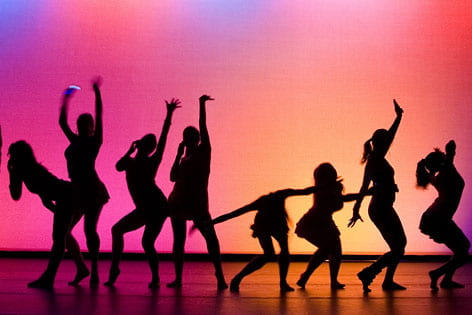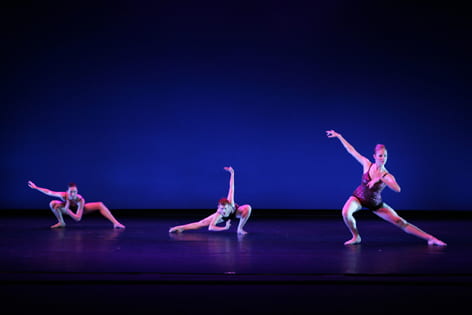Quantum mechanics of dance
Undergraduate dance student blends quantum physics and dance in production for upcoming Physical Graffiti show.
Caitlin Sikora, a choreographer in this year’s undergraduate dance showcase Physical Graffiti, looks at a room full of dancers and sees something a bit different from the average viewer. The senior dance and physics major – who admits she’s a rare breed – sees a stage populated with neutrinos and other subatomic particles.
“I’m using the mathematical structure of quantum mechanics – more specifically, neutrino oscillations – to make decisions during the choreographic process.” she explains. This structure is both the subject of her senior thesis in physics and the framework of her dance piece, in which Sikora explores concepts that link dance and physics.
“If you compare terms used to discuss dance and physics, you find a lot of overlap: time, space, energy, momentum, weight, force,” she says. “This overlap is not mere coincidence; dance and physics primarily deal with movement. I’m convinced that if dancers expand their understanding of movement and the associated concepts, they will become more capable participants in dance.”
This is Sikora’s second project for Physical Graffiti, which began in the mid-1970s to give undergraduates a forum to express themselves through choreography and performance, perform in groups, and demonstrate leadership. About 30 hopefuls audition each year, and less than half are selected by a dance faculty panel to create original works.
“For most of our students, this is their first opportunity to put on a show,” dance chair Lisa Naugle explains. “They follow a timeline that models the production process of a professional show, which includes meeting deadlines, managing dancers, and handling the pressures and commitments of the entire project.”
Students get to practice critical, creative and leadership skills in a supportive environment before they graduate, says Loretta Livingston, assistant professor and Physical Graffiti’s artistic director. It is costly, she says, for emerging choreographers to acquire this experience, so participation in Physical Graffiti or other school-supported productions provides important practical training.
“They start with the seed of an idea, flesh it out, take it to the stage and allow the public to see it,” Livingston says. “We want them to walk away with the confidence that they can create a new work from start to finish.”
As for Caitlin Sikora, it’s a chance to observe – first hand – those oscillating neutrinos and the influence of quantum mechanics on the art form known as dance.
Physical Graffiti will be staged at 8 p.m. Thurs.-Sat., May 7-9, in the Claire Trevor Theatre. A matinee is set for 2 p.m. Sat., May 9. Tickets are $9, $11 or $12.

